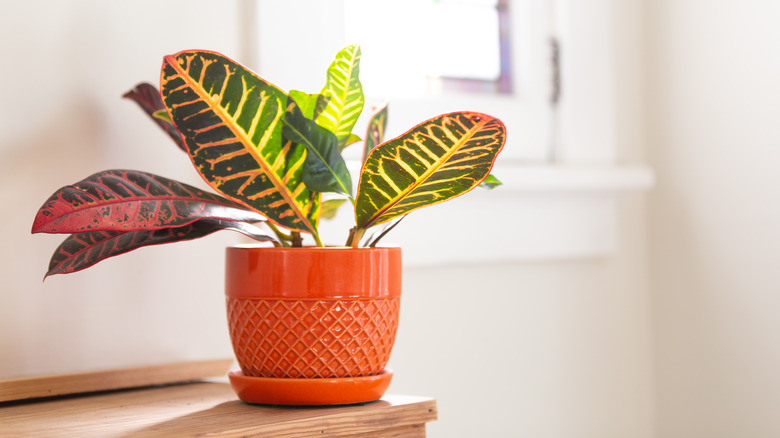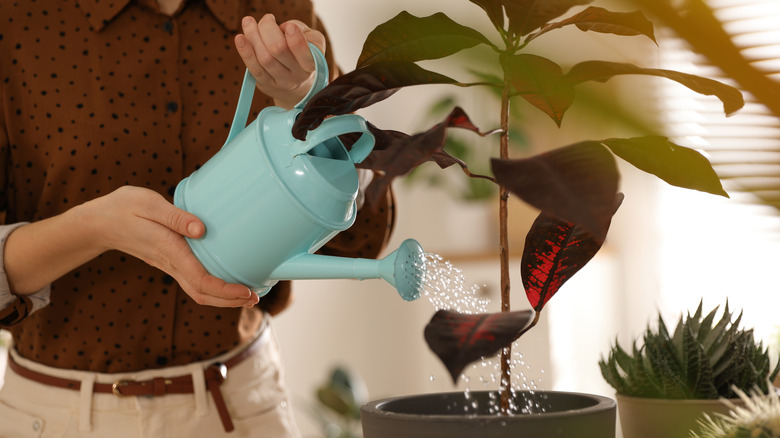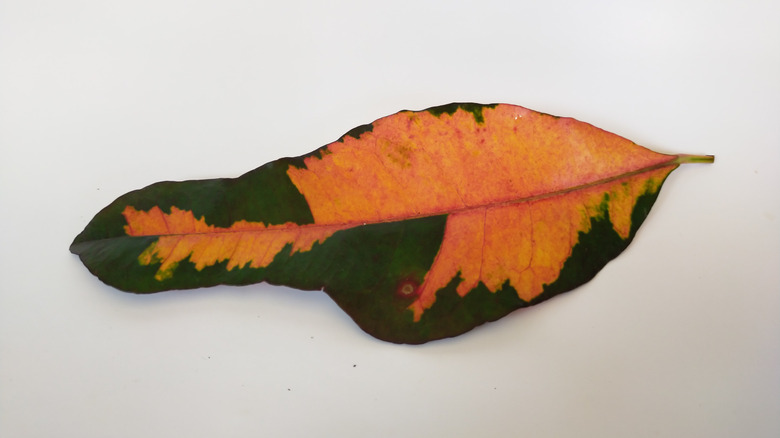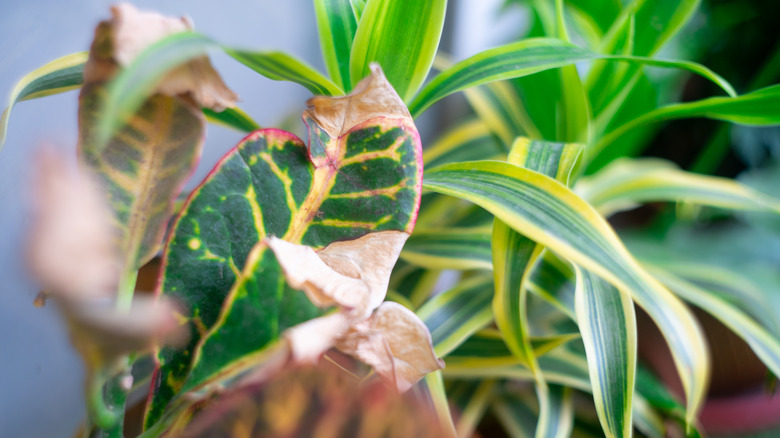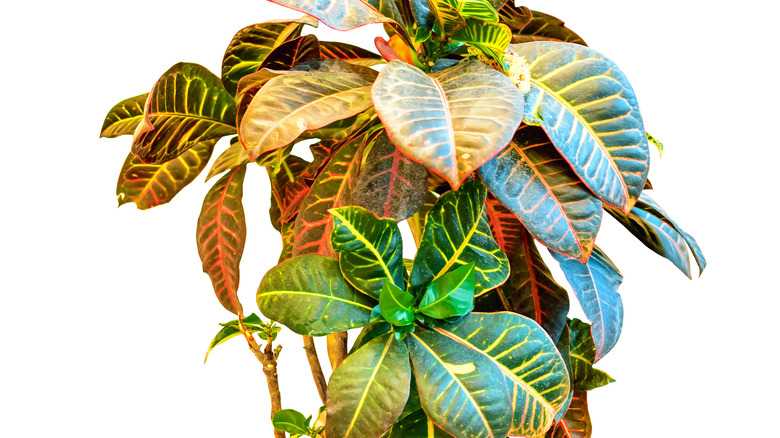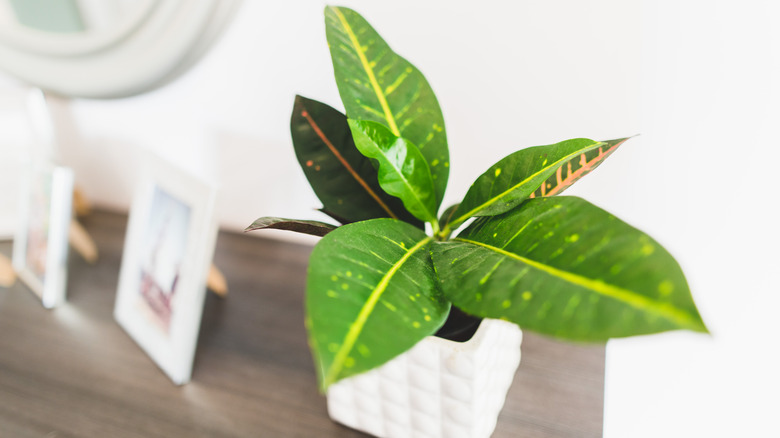Telltale Signs Your Croton Plants Are In Trouble
Croton plants have a reputation for being divas, but they earned that right thanks to their leaves. When you have such pretty foliage, you get to be a little bit fussy. So while croton plants don't require you to have a PhD in horticultural to take care of them, they might be a little tricky for beginners. Fortunately, there are certain telltale signs a croton plant is in trouble, but all of them are easily rectified if you catch the problem quickly. The good thing about these wildly patterned plants is that once you understand their kinks and needs, they become extremely easy to care for.
There's a reason why croton plants are often sold in bundles in grocery stores and given as house warming plants: They might be a tad fussy in the get-to-know-you stage, but they're easy to care for once you have a schedule set. These tropical plants love high sunlight, high humidity, plenty of water, and thrive when all three of those needs are met (via The Spruce). But you will know if they're floundering if one of these warning signs appear.
The croton plant is losing its leaves
If you bought your plant at a big box store or plant shop, then you might have gone through the harrowing experience of seeing your croton lose all of its leaves days after bringing it home. Rather than kicking yourself over killing your newly bought plant, give the croton some time to adjust. Gardening Know How explains that croton plants do not like to have their environment changed, and experience stress when they are moved. The stress causes them to lose their leaves, sometimes to the point of losing all of their foliage.
But don't throw out the plant, even if it's just a stalk! If you leave the croton securely planted in its new spot for a few weeks, the leaves will begin to bloom once more. Crotons prefer full sun, so make sure the plant is facing a south-facing window and is placed two to three feet from the pane. The new leaves will sprout green but will change colors when provided with plenty of light. Keep this in mind and the croton will become one of the easiest plants to grow.
The bottom leaves of the croton plant are falling off
While crotons experience leaf loss from stress (the way people experience hair loss from stress), not all leaf loss indicates strain. If your croton is only losing its bottom leaves, and those leaves are drying out and falling off, then this could be a sign of under-watering. During the summer, Bloomscape recommends watering the plant once the top inch of the soil is dry. But during the winter, Bloomscape recommends watering the plant once the top two inches of the soil is dry. Your plant is actively growing during the summer so it needs more water, but it is dormant during the winter and doesn't need as much sustenance.
When watering your croton plant, make sure you water it until you see water drain from the bottom of the pot. Over-watering only refers to the frequency of watering and not the amount, so the more water you give the plant during its watering session the better.
The tips of the croton plant's leaves are turning brown
If your croton's leaves are turning brown at the tips, then you might be dealing with one of two things: Either your tropical plant needs more humidity, or it is exposed to cold temperatures and needs to be moved. This colorful plant is native to Malaysia and India (via the University of Florida), so it likes warm weather and a balmy atmosphere. Because of that, you need to keep the humidity in your house around 40 to 80 percent for it to thrive. If your house has low humidity, you can create more moisture in the air by either placing the plant on a pebbled tray with some water, or investing in a small humidifier. The Spruce also warns that low humidity levels make the plant vulnerable to spider mites, which is every plant owner's nightmare.
In addition to requiring high humidity, croton plants also dislike cold temperatures, and can brown at the edges or lose leaves if they experience cold drafts. Gardening Know How recommends keeping them in temperatures that hover above 60 degrees, and to keep them away from drafty windows or doors.
The croton plant's leaves are drooping
If your croton's leaves are drooping or wilting, then that could be a sign of under-watering. Since croton plants need plenty of bright sunlight, they also need plenty of water to counteract that blast of daily heat. If you walk into your room and see that your croton's leaves have collapsed into a wilt, then check the soil. Garden Superior notes that croton plants like their soil to be consistently moist during the summer, so if the top inch is bone dry, then that could mean that your croton is thirsty and is ready to be watered.
If you thoroughly watered your croton but it still looks a tad limp, pour water into a saucer and bottom-water the plant. This way the thirsty croton will take in as much water as it needs to in order to perk back up. Let the plant sit in the water for about 10 minutes before removing it.
The leaves of the croton plant are turning green
If your croton loses its bright colors and turns green, then your plant might be receiving too little light. While the plant will survive in medium light, it won't produce as much foliage and its colors will fade back to green (via MiracleGro).
But remember — there is also such a thing as too much of a good thing. While croton plants love sun, you don't want them underneath a blazing, harsh light. Too much direct, intense sunlight will just burn the leaves, so you want to provide the croton with some shade (if outside) or place it in front of a curtain if indoors (via Plant Care Today). According to SFGate, you will know if the sunlight is too strong if the colors of the croton begin to fade, much like how a painting fades if it is exposed to constant bright sunlight.
These are some of the most common telltale signs that your croton plant is in trouble, but if you catch them quickly, your croton will continue to thrive. Look for these red flags, and you will have a green thumb in no time!
